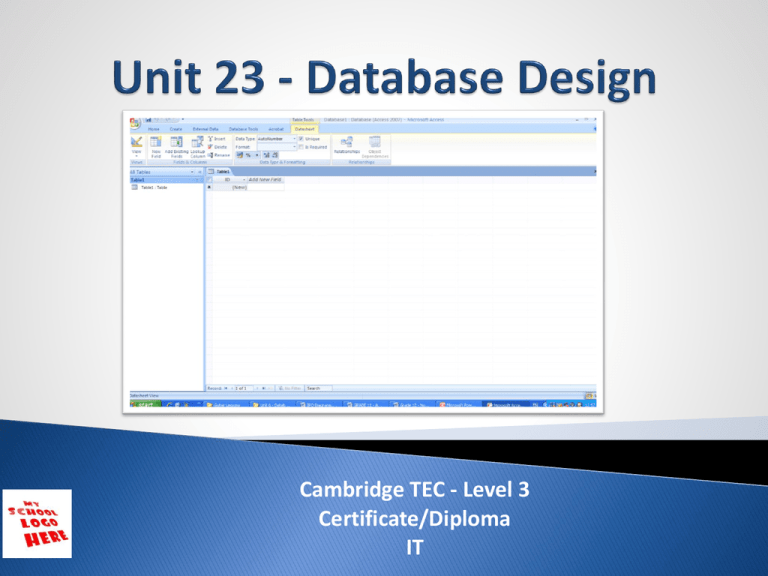Unit 23 - Enderoth
advertisement

Cambridge TEC - Level 3 Certificate/Diploma IT Scenario LO1 LO2 LO3 L01 - Understand the features of a relational database Scenario LO1 LO2 LO3 Within a report, you need to provide evidence for the following 7 areas: 1. 2. 3. 4. 5. 6. 7. What is a Database? Database Objects Naming Conventions Data Types Primary and Foreign Keys Relationships Field Properties Scenario LO1 LO2 LO3 Definitions: A database is a collection of information that is organized so that it can easily be accessed, managed, and updated. A database is a useful tool for many different types of applications - used mostly with storing data. There are built in functions/features that can help you analyse the data and produce customised reports. Databases can store very large numbers of records efficiently (they take up little space). It is very quick and easy to find information. It is easy to add new data and to edit or delete old data. Data can be searched easily, eg 'find all Ford cars'. Data can be sorted easily, for example into 'date first registered' order. Data can be imported into other applications, for example a mail-merge letter to a customer saying that an MOT test is due. More than one person can access the same database at the same time - multiaccess. Security may be better than in paper files. Scenario LO1 LO2 LO3 A database table is similar in appearance to a spreadsheet, in that data is stored in rows and columns (flat file). As a result, it is usually quite easy to import a spreadsheet into a database table. The main difference between storing your data in a spreadsheet and storing it in a database is in how the data is organized. A relational database holds its data over a number of tables not just one. Records within the table are linked (related) to data held in other tables. ◦ Task 1 (P1.1) – What is a database? Give examples. Scenario LO1 LO2 LO3 Tables A table is a data structure that organizes information into rows and columns. A database table is similar in appearance to a spreadsheet. Queries Queries are the real workhorses in a database, and can perform many different functions. Their most common function is to retrieve specific data from the tables. Forms Forms are sometimes referred to as "data entry screens." They are the interfaces you use to work with your data Reports Reports are what you use to summarize and present data in the tables. A report usually answers a specific question. Task 2 (P1.2) – Describe the above database objects. Give examples. Scenario LO1 LO2 LO3 Leszynski Naming Convention – Standardising your Database When designing a database a good way to name all of the elements are: Tables – Tbl_name Query – Qry_name Forms – Frm_name Reports – Rpt_name Where name represents the content or purpose of the element. For example Tbl_customer would be a customer table Qry_todaysbookings would be a query to illustrate all of today's bookings (You must use this throughout your database) Task 3 (P1.3) – Why use naming conventions? Give examples. Scenario LO1 LO2 LO3 Data Type A data type is a type of data. Of course, that is rather circular definition, and also not very helpful. Therefore, a better definition of a data type is a data storage format that can contain a specific type or range of values ◦ Autonumber – the database generates a unique number for each record stored, so that it can be used as a primary key and reference only ONE record ◦ Text – store alpha and numeric values ◦ Number – store only numeric values with/without decimal places (use format option to determine whole numbers or decimal numbers) ◦ Date/Time – store date and/or time values (use format option to determine range of information collected) ◦ Currency - store only numeric values with decimal places (use format option to determine currency type) ◦ Boolean – store an option of two values. Task 4 (P1.4) – What are datatypes? Give examples. Scenario LO1 LO2 LO3 Primary Key A primary key is a column or group of columns that uniquely identify a row. Every table should have a primary key. Foreign Key A foreign key is a column or set of columns in one table whose values must have matching values in the primary key of another table. A foreign key is said to reference its primary key. Foreign keys are a mechanism for maintaining data integrity. Task 5 (P1.5) – What are Primary Keys and Foreign Keys? Give examples. Scenario LO1 LO2 LO3 In a relational database, relationships enable you to prevent redundant data. To make sure that you data stays synchronized, you can enforce referential integrity between tables. One-to-many relationships A one-to-many relationship is the most common kind of relationship. In this kind of relationship, a row in table A can have many matching rows in table B. But a row in table B can have only one matching row in table A. One-to-one relationships In a one-to-one relationship, a row in table A can have no more than one matching row in table B, and vice versa. This kind of relationship is not common. Many-to-many relationships In a many-to-many relationship, a row in table A can have many matching rows in table B, and vice versa. You create such a relationship by defining a third table that is called a junction table. Task 6 (P1.6) – What are the differing database relationships? Give examples. Scenario LO1 LO2 LO3 Every field in a table has properties. These properties define the field's characteristics and behaviour. The most important property for a field is its data type. Task 7 (P1.7) – What are filed properties? Give examples. L02 - Be able to design, create and populate a relational database Scenario LO1 LO2 LO3 Cube Systems, a business that manufactures customised PC machines, needs the help of your expertise to design and implement a database system that handles the sales methods of recording business transactions. Cube systems would like a fully functional and automatic Relational Database system which could incorporate: ◦ A customer page – where customers can be added, edited and viewed ◦ A customer orders page – where customer orders can be viewed ◦ A product page – where all the products for sales can be added, edited and viewed ◦ A ordering page – where all the orders can be added, edited and viewed ◦ A invoice page – where the user selects what the customer requires and prints the invoice ◦ A reporting page – where reports such as the analysis of: Orders of any particular product Profit made on each product Tracking of customer orders and purchases Calculating totals of ordered product over a given period Customers traced based on any other information required Scenario LO1 LO2 LO3 Businesses (whether they small or large) depend on the reliability / success of methods used to record/manage business transactions. With the use of a complex database systems, mundane transactions are made relatively easy for businesses to process. Therefore businesses require employees to have some knowledge, understanding and skills to use and manage these types of systems in the correct manner. During this learning objective, you need to evidence your knowledge, understanding and skills for the use of a database application: ◦ key concepts of database ◦ features Database Objects (tables, queries, forms and reports) Naming Conventions (Leszynski Naming Convention) Data Types (Autonumber, Text, Number, Date/Time, Currency, Yes/No, Memo, Lookup) Primary and Foreign Keys Relationships (one-to-one, one-to-many, many-to-many) Field Properties (field name, field size, format, input mask, default value, validation rule, lists) Identify the uses and purposes of various different database systems - scenarios - stock control Understand what they show and how to interpret the data e.g. trends, comparisons, etc… Scenario LO1 LO2 LO3 Cube Systems, a business that manufactures customised PC machines, needs the help of your expertise to design and implement a database system that handles the sales methods of recording business transactions. Cube Systems have identified the need for a complex database system which will contribute to the success of the each order processed and make some tasks relatively easy for the business. Cube Systems have been very successful with their sales of customised computers and software. This has resulted in the need to store large quantities of data and produce a variety of well structured reports. Knowing the power of Relational Databases to store the large amounts of data and produce reports, they have decided to develop a Relational Database for their customers and sales. The current system used at Cube Systems is a paper-based system, which requires the employees (call centre) to manually complete forms for every customer order, lookup details from manuals regarding the products and pricing, send details to the warehouse/shop floor for the development team to create the customised order from the hand-written forms and then finally despatch the orders to the customers. As you have noticed, this is an out-dated process, which has several potential problems. Your mission, if you choose to accept it, is to design and implement a complex database system that will meet the assessment objectives: Understand the features of relational databases Be able to design, create and populate a relational database Be able to test a relational database See next slide for additional information for this system Scenario LO1 LO2 LO3 Cube Systems have been very successful with their sales of customised computers and software. This has resulted in the need to store large quantities of data and produce a variety of well structured reports. Knowing the power of Relational Databases to store the large amounts of data and produce reports, they have decided to develop a Relational Database for their customers and sales. REMEMBER: Customers choose the configuration of computer based on multiple choices such as the speed of the processor, size of the RAM, monitor or hard drive and software. Certain options do attract discounts and customers have delivery options such as next day, 2 day or 4 day which all have different price points – if the customer spends over a certain price point they will get free delivery. Continues on next slide Scenario LO1 LO2 LO3 Cube systems would like a fully functional and automatic Relational Database system which could incorporate: ◦ A customer page – where customers can be added, edited and viewed ◦ A customer orders page – where customer orders can be viewed ◦ A product page – where all the products for sales can be added, edited and viewed ◦ A ordering page – where all the orders can be added, edited and viewed ◦ A invoice page – where the user selects what the customer requires and prints the invoice ◦ A reporting page – where reports such as the analysis of: Orders of any particular product Profit made on each product Tracking of customer orders and purchases Calculating totals of ordered product over a given period Customers traced based on any other information required Scenario LO1 LO2 LO3 P2 - Design a relational database for a specified user need M1 - Justify choices made in the design of the relational database P3 - Create and Populate a database P4 - Create features in data entry forms to ensure validity and integrity of data M2 - Create a user input form to enter data D1 - Create a start-up menu/navigation for users Scenario LO1 LO2 LO3 Focusing on the needs of Cube Systems for a database system to manage the sales/orders, you need to provide evidence for the following 13 tasks within this case study: 1. 2. 3. 4. 5. 6. 7. 8. 9. 10. 11. 12. 13. Purpose and Audience Database Activities Normalisation Data Dictionary Entity Relationship Diagram (ERD) User Interface Designs Designs for Forms Implement Database Tables Relationships Input Data into the Tables Forms Advanced Forms Switchboard For additional information within this section of the coursework unit, please see Unit 23 - Database Notes Scenario LO1 LO2 LO3 Cube’s CEO has explained that the main users of the database will be call centre staff. Task 1 (P2.1) – You need to explain that you have understood what the purpose of the new Relational Database system is and the audience who will be using it ◦ You should detail exactly what the database needs to do ◦ Think about: who the audience is Functional Requirements (what the user wants the system to do) Non-functional Requirements performance constraints (response time / availability of system / growth capacity / record retention) development constraints (cost / time / resources) Design Objectives (ease of use / what skills do they have / what assistance will they need in order to use the database) House style and use of images Scenario LO1 LO2 LO3 Your database must have a sheet that stores customer information and some detail about what the customer has bought or spent. OR Information about the products and how much they were bought for (trade price, Profit, VAT etc...) Basically information that can be processed using a variety of tools such as filtering, graphs, goal seek. -----------------------------------------------------------------------------------------Task 2 (P2.2) – Describe exactly how the Relational Database is going to work. Explain all the inputs, how these are going to be processed and what outputs there will be ◦ Before you begin the database CUBE’s CEO must see a detailed plan of the proposed system ◦ REMEMBER – The database system will contain at least three separate tables Input Album title Artist name Artist ID Process Query and Report Output Display or print lists of albums produced by particular artists Scenario LO1 LO2 LO3 Normalisation is the process of sorting data into logical and simple structures for databases. It eliminates data that repeats itself. 1st Normal Form (1NF) - Tables do not contain repeating data 2nd Normal Form (2NF) - Tables do not contain fields that are not needed within that particular table ◦ For example in our holiday example in the booking table you would not need price of the holiday as this is stored within the holidayUnnormalised table and the linkData allows this information to be shared 3rdOrder Normal Form (3NF) - Tables Number Date do not contain any fields that could act as a primary key (ie unique) other than the one used as a primary key Title Last Name Company BenefitsAddress of normalisation include: Town County Reduction of data redundancy CPU database efficiency RAM Hard Drive Greater Database can be updated and amended easier Monitor Monitor Size Software Database takes up less memory which leads to quicker operations Post Code Quantity First Name Trade Price Sale Price Graphics Delivery Price Discount For further information concerning normalisation and examples, please refer to “Unit 23 - LO2 - Database Notes” -------------------------------------------------------------------------------------------Task 3 (P2.3) – Briefly explain what Normalisation is and why it is beneficial to perform it Task 4 (M1.1) – Using the un-normalised dataset, normalise to the 3rd Normal Form, justifying all the entities (tables) and attributes during each stage (click to view potential data fields) ◦ You should have a minimum of three tables ◦ Explain and justify any changes made during the 3 stages Scenario LO1 LO2 LO3 A data dictionary is a list of all the tables within a database showing all the fields and their attributes Field Name Name of the field Data Type Autonumber Text Number Date/time Currency Yes/No Memo Lookup Primary Key Field Size or Foreign Key Numeric value to represent the length of the value acceptable Primary key or Foreign key Indexed Yes or No Input Mask or Validation Rule 0, 9, #, L, ?, A A, &, C, <, > Potential problems / Justification of design Explain the reason for using each feature within the field and table Task 5 (P2.4) – Produce a data dictionary for the 3 tables identified from Task 4 Task 6 (M1.2) – Justify the identification of the entities (tables) Input masks Default value Validation rule Lists Scenario LO1 LO2 LO3 Data Type ◦ Autonumber – the database generates a unique number for each record stored, so that it can be used as a primary key and reference only ONE record ◦ Text – store alpha and numeric values ◦ Number – store only numeric values with/without decimal places (use format option to determine whole numbers or decimal numbers) ◦ Date/Time – store date and/or time values (use format option to determine range of information collected) ◦ Currency - store only numeric values with decimal places (use format option to determine currency type) ◦ Yes/No – store an option of two values ◦ Memo – Text field that store up to 65,535 characters ◦ Lookup – provide a pre-defined list of options or link to another table for options Scenario LO1 LO2 LO3 Field Size ◦ number for characters that can be stored within the field e.g. – 10 – would represent ONLY 10 characters to be stored within the field, if more characters are provided then a data validation error would occur Primary Key ◦ unique reference id for each record stored within a table, so that it can be referenced and link to only ONE record When the Primary key is linked from another table, then this called a foreign key Indexed ◦ Used when two or more tables are joining a table based on the field name by performing/identifying this step, it allows the database to access information from other tables and performance of searching the table based on this field Scenario LO1 LO2 LO3 Input Mask ◦ can be used as data validation check when storing information in a certain/required format e.g. – using the table below, you pre-define the format required for storage Character Description 0 Digit (0 to 9, entry required, plus [+] and minus [–] signs not allowed) 9 Digit or space (entry not required, plus and minus signs not allowed) # Digit or space (entry not required; spaces are displayed as blanks while in Edit mode, but blanks are removed when data is saved; plus and minus signs allowed) L Letter (A to Z, entry required) ? Letter (A to Z, entry optional) A Letter or digit (entry required) a Letter or digit (entry optional) & Any character or a space (entry required) C Any character or a space (entry optional) < Causes all characters to be converted to lowercase > Causes all characters to be converted to uppercase Scenario LO1 LO2 LO3 Task 7 (P2.5) – Produce an Entity Relationship Diagram for the Relational Database ◦ An Entity Relationship Diagram shows how tables are joined (related) to each other ◦ Tables are joined (related) in a Relational Database through Primary and Foreign Keys ◦ These relations come in three forms: One-to-Many Many-to-One One-to-One For further information concerning ERD and examples refer to “Unit 23 – LO2 – Database Notes” Scenario LO1 LO2 LO3 A user interface is the screen which provides the user with the necessary buttons to use the Database. ◦ Navigation system within the database - to indicate the various parts of the interface The buttons above open the relative forms: Lessons, Sale Price, Customers, Sale Item, Employees and Stock. The Help button opens a splash screen that details help on the buttons and their functions. Task 8 (P2.6) – Design a user interface to access parts of database ◦ Include colours, company logo, etc… ◦ Remember to annotate all your designs Scenario LO1 LO2 LO3 These forms allow the user to change data in the database. You should include all aspects in your design including drop-down lists, logos, text boxes, text, etc. The text box allows you to edit the Sales ID and the item field has a dropdown list for the user to choose from. The text boxes above allow users to add / edit Customer details. This will be saved once completed. Buttons / Images Task 9 (P4.1) – Design a variety of forms for adding and amending data within the Database Remember to annotate all your designs to ensure validity and integrity of data Consider the use of sub-forms, which relate to other tables Scenario LO1 LO2 LO3 Task 10 (P3.1) – Based on the data dictionary designs (Task 5) for the tables within your database, create them using an appropriate software ◦ Remember you need to use only the fields you have documented within your data dictionary ◦ Provide screenshot evidence of any features used during the creation of the tables verification and validation routines; input masking dropdown or combo boxes checks for completeness (field sizes) data consistency data redundancy Scenario LO1 LO2 LO3 You now need to decide on how your tables will be related to each other REMEMBER that ALL the tables created are independent of each other but require you to link them together where appropriate so that the dynamics, integrity of information and performance is provided ◦ Links to the other tables with the use of primary key (foreign key) gives access to all of the information within that table For example in the sales table you should have the customer ID through that number you have access to all the information about any particular customer that is stored in the customer table If the customer ID does not exist within the customer table, then the database should identify and acknowledge the user that an integrity violation has occurred Task 11 (P3.2) - Based on the database table structures, you need to explain exactly which fields link to each other Justify and explain your choices made Refer to any of the relationships created between the tables Task 12 (M1.3) – Explain HOW you have enforced the referential integrity between the tables Scenario LO1 LO2 LO3 Task 13 (P3.3) – Show evidence of data inserted into the tables created Input up to 60 records in the all the tables created Use the “Unit 23 – Sample Customer” for data that can be used for the customer table Scenario LO1 LO2 LO3 Forms are created to make it easier to enter data into databases Buttons can be placed on forms to perform certain functions such as opening other forms or running queries Task 14 (P4.2) – Create the forms based on the designs produced for your database Provide screenshot evidence for creating the forms including any validation methods used Scenario LO1 LO2 LO3 Forms are created to make it easier to enter data into databases Buttons can be placed on forms to perform certain functions such as opening other forms or running queries Sub forms consist of two or more forms and show information relating to each other Customer information Holiday information Task 15 (M2) – Design and create forms which will utilise the use of: Sub-forms Calendar Others Scenario LO1 LO2 LO3 Customise Database The end user wants you to add a user interface using a switchboard ◦ The end user wants you to customise the user interface to meet the needs of a defined user type -------------------------------------------------------------------------------------Task 16 (D1) – Customise and/or implement a user interface allowing access to all areas of the database Produce annotated screen shots showing how you have done this and why ◦ This could be to make it look more professional – inclusion of logos, house style, etc… ◦ Add functionality (access to more areas/different options) L03 - Be able to test a relational database Scenario LO1 LO2 LO3 Cube Systems have been very successful with their sales of customised computers and software. This has resulted in the need to store large quantities of data and produce a variety of well structured reports. Knowing the power of Relational Databases to store the large amounts of data and produce reports, they have decided to develop a Relational Database for their customers and sales. REMEMBER: Customers choose the configuration of computer based on multiple choices such as the speed of the processor, size of the RAM, monitor or hard drive and software. Certain options do attract discounts and customers have delivery options such as next day, 2 day or 4 day which all have different price points – if the customer spends over a certain price point they will get free delivery. Continues on next slide Scenario LO1 LO2 LO3 Cube systems would like a fully functional and automatic Relational Database system which could incorporate: ◦ A customer page – where customers can be added, edited and viewed ◦ A customer orders page – where customer orders can be viewed ◦ A product page – where all the products for sales can be added, edited and viewed ◦ A ordering page – where all the orders can be added, edited and viewed ◦ A invoice page – where the user selects what the customer requires and prints the invoice ◦ A reporting page – where reports such as the analysis of: Orders of any particular product Profit made on each product Tracking of customer orders and purchases Calculating totals of ordered product over a given period Customers traced based on any other information required Scenario LO1 LO2 LO3 P5 - Perform queries using multiple table and multiple criteria M3 - Create complex output documentation using tables and queries P6 - Include an advanced feature in a database deisgn P7 - Test a relational database M4 - Carry out improvements to the relational database following user feedback D2 - Evaluate the relational database including improvements made Scenario LO1 LO2 LO3 Focusing on the needs of Cube Systems for a database system to manage the sales/orders, you need to provide evidence for the following 8 tasks within this case study: 1. 2. 3. 4. 5. 6. 7. 8. Purpose and Audience Database Activities Normalisation Data Dictionary Entity Relationship Diagram (ERD) User Interface Designs Designs for Forms Designs for Reports See the following documents for additional information within this section of the coursework unit 1. Unit 06 - AO1 – Normalisation 2. Unit 06 - AO1 - Notes Scenario LO1 LO2 LO3 Queries are questions you ask the database. Queries can be customised to give different results using operators: Equal = Not <> Greater than > Between BETWEEN ? AND ? Less than < Task 1 (P5.1) – Create a table as shown to describe and use a range of different queries within your database that utilise the multiple linked tables: At least three different logical operators Parameter queries Query Name Description At least three different range operators Crosstab queries Tables Fields Calculated fields Parameter Potential Query problems Appropriate name for query Explain what you expect to gather from the table Table you will query Fields that used during the query Value used to search for information from the table Explain any problems within the query Qry_customerspe nd500ormore Displays all customers spending over £500 Tbl_Customer Tbl_Orders Forename, Surname, PhoneNo, Price, Destination >500 Correct operator used and numeric value provide as a parameter Task 2 (P5.2) – Create the queries based on the designs produced within your database Provide screenshot evidence for creating the queries Scenario LO1 LO2 LO3 To make a query ask for criteria when you run it, create a parameter query. This allows you to use the same query over and over without having to constantly open it in Design view (Design view: A view that shows the design of these database objects: tables, queries, forms, reports, and macros. In Design view, you can create new database objects and modify the design of existing objects.) to edit the criteria. Parameter A parameter is a piece of information you supply to a query right as you run it. Parameters can be used by themselves or as part of a larger expression to form a criterion in the query. You can add parameters to any of the following types of queries: ◦ Select ◦ Crosstab ◦ Append ◦ Make-table ◦ Update Criteria are the “filters” you add to a query to specify which items are returned when you run the query. Creating a parameter is similar to adding a normal criterion to a query: Create a select query, and then open the query in Design view. In the Criteria row of the field you want to apply a parameter to, enter the text that you want to display in the parameter box, enclosed in square brackets. For example, [Enter the start date:] You can use multiple parameters in a criterion. For example, Between [Enter the start date:] And [Enter the end date:] will generate two prompts when you run the query. Scenario LO1 LO2 LO3 A crosstab query is a type of select query (select query: A query that asks a question about the data stored in your tables and returns a result set in the form of a datasheet, without changing the data.) used to arrange summary data – sums, averages, counts, and similar functions – into two category schemes, one of which is often time periods. For example, you might use a crosstab to show total sales by region per month. The way the results are arranged in a crosstab query can make it easier to read than a simple select query that displays the same data, as shown in the following illustration. This select query groups summary data vertically by employee and category. This crosstab query displays the same data, grouped both horizontally and vertically. When you create a crosstab query, you specify which fields contain row headings, which field contains column headings, and which field contains values to summarize. You can use only one field each when you specify column headings and values to summarize. You can use as many as three fields when you specify row headings. One, two, or three columns on this side contain row headings. The names of the fields that you use as row headings appear in the top row of these columns. The row headings appear here. The number of rows in the crosstab datasheet can grow quickly when you use more than one row heading field, because each combination of row headings is displayed. The columns on this side contain column headings and summary values. Note that the name of the column heading field does not appear on the datasheet. Scenario LO1 LO2 LO3 The Crosstab Query Wizard makes you choose a single table or query as the record source for your crosstab query. If a single table does not have all the data that you want to include in your crosstab query, start by creating a select query that returns the data that you want. For more information about creating a select query. 1. On the Create tab, in the Query group, click Query Wizard. 2. In the New Query dialog box, click Crosstab Query Wizard, and then click OK. 3. On the first page of the wizard, choose the table or query that you want to use to create a crosstab query. 4. On the next page, choose the field that contains the values that you want to use as row headings. 5. You can select up to three fields to use as row headings sources, but the fewer row headings you use, the easier your crosstab datasheet will be to read. 6. On the next page, choose the field that contains the values that you want to use as column headings. In general, you should choose a field that contains few values, to help keep your results easy to read. For example, using a field that has only a few possible values (such as gender) might be preferable to using a field that can contain many different values (such as age). If the field that you choose to use for column headings has the Date/Time data type, the wizard adds a step that lets you specify how to group the dates into intervals, such as months or quarters. 7. If you choose a Date/Time field for column headings, the next page of the wizard asks you to specify the interval to use to group the dates. You can specify Year, Quarter, Month, Date, or Date/Time. If you do not choose a Date/Time field for column headings, the wizard skips this page. 8. On the next page, choose a field and a function to use to calculate summary values. The data type (field data type: A characteristic of a field that determines what kind of data it can store. For example, a field whose data type is Text can store data consisting of either text or numeric characters, but a Number field can store only numerical data.) of the field that you select determines which functions are available. 9. On the same page, select or clear the Yes, include row sums check box to include or exclude row sums. 10. If you include row sums, the crosstab query has an additional row heading that uses the same field and function as the field value. Including a row sum inserts an additional column that summarizes the remaining columns. For example, if your crosstab query calculates average age by location and gender (with gender column headings), the additional column calculates the average age by location, across all genders. 11. On the next page of the wizard, type a name for your query and then specify whether you want to view the results or modify the query design. Scenario LO1 LO2 LO3 The main benefit of calculated columns is encapsulation, which leads to cleaner database design. It allows database developers to define the most common fields at the table level. This makes applications easier to maintain as inevitable bugs creep up in expressions. Calculated columns are easy to create. Open the table in browse view. From the ribbon, select Table Tools | Fields | Add & Delete | More Fields | Calculated Field or choose the Calculated field type in table design view. Either way, the expression builder will help create the expression. Or 1. Open the query in Design view 2. Type an expression in an empty cell in the Field row. If the expression includes a field name, you must place brackets around the name. 3. After you press ENTER or move to another cell, Microsoft Access enters the default field name ExprN, where N is an integer incremented for each new expression field in the query. The name appears before the expression and is followed by a colon. In a datasheet, this name is the column heading. 4. You can select ExprN and type a more descriptive name, such as NewPrice. 5. If the expression includes one or more aggregate functions (Sum, Avg, Count, Min, Max, StDev, or Var), and if the design grid includes another field or fields that you want to use for grouping, click Totals on the toolbar (unless the Total row is already displayed). Leave Group By in the Total cell for the grouping field, and in the calculated field, change Group By to Expression. Scenario LO1 LO2 LO3 Reports are a different way of displaying information either from a query or table. Task 3 (M3.1) - Sketch the reports you are going to use Remember you should show what information and graphics is going to go where on the report Task 4 (M3.2) – Create the reports based on the designs produced for your database Provide screenshot evidence for creating the reports Refer to the Database Activities (LO2 - Task 2) to design the reports for any outputs that are produced, both printable and on screen Scenario LO1 LO2 LO3 Within a database software, advanced features such as a macro or customising toolbars and menus. Task 5 (P6.1) - Create a macro that will print from a form produced within your database Provide screenshot evidence for creating the macro Task 6 (P6.2) – Customise the toolbar/menu system currently used within the database Justify the shortcuts used within the database Scenario LO1 LO2 LO3 Task 7 (P7.1) – Explain how you have met the end user requirements. Explain how the functionality and operations work. ◦ Remember look back at your purpose and audience and justify why you have produced the database. ◦ Explain how you have met the users needs. Task 8 (P7.2) – Create a test table to cover the main areas of your database Housestyle Queries Forms Reports Navigation Switchboard Test data type: 1. Operational – No data as such 2. Normal - What you would expect to be used. 3. Erroneous - Data that should produce an error ie ‘twenty’ instead of 20 4. Boundary - Testing to see if the validation operates eg if you are expecting a value between 1 and 10 but get a number above 10, such as 11 5. Extreme - Very large numbers to see if the database handles the number. Scenario LO1 LO2 LO3 Task 9 (M4.1) – Produce an questionnaire that will aid user feedback evaluation on your database that focuses on the case study presented to you in L02 Purpose and Audience User Requirements How I met the purpose How I have helped the audience How does the operation / functionality help the end users How the database can be improved Task 10 (M4.2) – Get 3 user feedback responses using the questionnaire Task 11 (M4.3) – Analyse feedback responses gathered identify and justify the improvements necessary for the database Carry out the improvements to the database, with evidence Task 12 (D2) – Produce a self evaluation of your database that focuses on the case study presented to you in L02 Purpose and Audience User Requirements How I met the purpose How I have helped the audience How does the operation / functionality help the end users How the database can be improved









